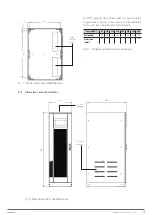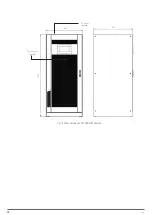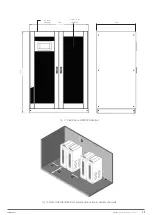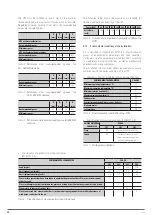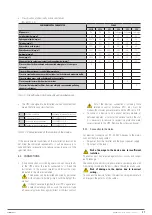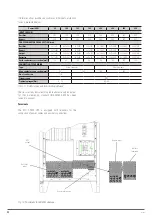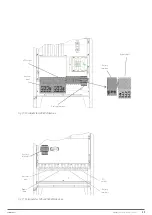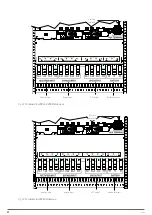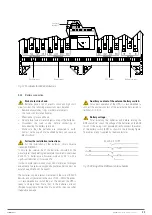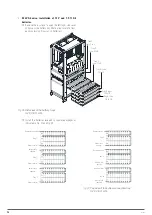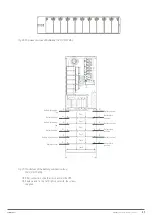
12
SALICRU
Mains
Mains
Output
Fig. 8.
Load powered through the bypass line.
4.6.4. Battery operation.
In the event of power failure or rectifier fault, the batteries
will power the inverter without interruption. The voltage of the
batteries decreases depending on the value of the discharge
current. The drop in voltage does not affect the output voltage,
which remains constant thanks to pulse width modulation
(PWM).
In the event that supply is restored before the batteries are
completely discharged, the system will return to normal
operation automatically. If it is not, the inverter shuts down and
the load is transferred to the bypass line (bypass operation).
If the bypass line is not available or is outside the tolerance
limits, the powering of the load is interrupted as soon as the
batteries reach the discharge threshold limit (black-out).
As soon as the power is restored, the rectifier will recharge
the batteries. In the standard configuration, the loads are
powered again through the SSB static switch when mains
power becomes available again. The inverter restarts when the
batteries have partially recovered their capacity.
System restart from a condition of discharged batteries
(
black-out
) can be customised according to the needs of the
device in three ways:
Bypass. The loads are powered as soon as the bypass
line is available (factory setting).
Inverter. The loads are powered through the inverter
(even if the bypass line is available) when the battery
voltage has reached the programmed threshold/level
after the restart of the rectifier. This involves additional
waiting time (which will depend on how discharged the
batteries are) to power the loads from the moment the
bypass is enabled.
Manual inverter. The output power is not restored
automatically. The system requires a confirmation
to restart, which can be done manually by the user
through the front panel.
Output
Mains
Mains
Fig. 9.
Battery operation.
4.6.5. Manual bypass.
Intervention of the manual bypass is necessary whenever
it is required to verify the functionality of the UPS, or during
maintenance or repair work.
Output
Mains
Mains
Fig. 10.
Manual bypass for function checks.
Follow the procedures described in the manual.
The switching and return sequence of the manual
bypass must be carried out in accordance with the procedure
indicated in the relevant chapter of this document. The user will
be solely responsible for any faults caused to the UPS, loads
and/or installation as a result of incorrect actions.
Wiring of the auxiliary contacts.
Carry out an appropriate electrical installation by
connecting the auxiliary contacts of the manual bypass and
the output circuit breaker to the relevant terminals of the
UPS. This will allow the control logic to acquire the state of
the switches and guide the operator during start and manual
bypass procedures.
While the device is in manual bypass mode for repairs or
maintenance, the UPS is completely switched off and the load
is powered directly through the bypass line.
Output
Mains
Fig. 11.
Manual bypass for repairs or maintenance.
4.7. OPERATION AND CONTROL DEVICES.
The UPS’s operation and control devices are indicated below:
•
Rectifier circuit breaker (RCB)
•
Static bypass circuit breaker (SBCB)
•
UPS output circuit breaker (OCB)
•
Manual bypass circuit breaker (MBCB)
•
Battery circuit breaker/switch (BCB). External, in the battery
cabinet
•
Emergency power off button (EPO)
•
Normal/Bypass selector
•
Control panel with LCD display (powers between 80...160kVA)
or touch screen (powers between 200...300kVA)
Summary of Contents for SLC X-PERT Series
Page 1: ...SLC X PERT 80 400 kVA UNINTERRUPTIBLE POWER SUPPLIES UPS USER MANUAL...
Page 8: ...8 SALICRU Fig 3 Front view of the 400 kVA model...
Page 34: ...34 SALICRU Fig 42 Connection of three UPSs through the CAN bus for 400 kVA devices...
Page 60: ...60 SALICRU...
Page 61: ...61 X PERT UNINTERRUPTIBLE POWER SUPPLIES UPS USER MANUAL...

















